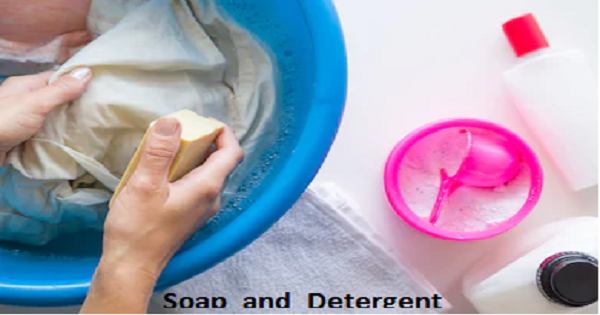The difference between the soap and the detergent
The soaps are sodium or potassium salts of the long-chain molecules of carboxylic acids and detergents are sulphonic salts of long-chain molecules of carboxylic acids before we understand what is soap and detergent in detail we required to get the knowledge of what is saponification because it is the process used in manufacturing soap.
Click for online shopping
Future Study Point.Deal: Cloths, Laptops, Computers, Mobiles, Shoes etc
Saponification is the reaction between ester and sodium or potassium hydroxide producing alcohol and subsequent reaction of sodium or potassium salts of carboxylic acid which is known as soap. This process is completed in two steps.
You can also study
What are the physical and chemical properties of metals?
NCERT Solutions Class 10 Science from chapter 1 to 16
Class 10 chemistry Viva Voce Questions and Answers
Class 10 Chemistry Practical Based Questions and Answers
What is the atom, molecule, and atomicity of a substance?
How to determine Valency,net charge of an ion and Molecular formula of a substance.
What is an atom,molecule and atomicity of a substance?
Type of Chemical Reactions with Complete detail
What is pH value and its importance in everyday life.
Chemical properties of Acid and Bases-A note for grade 10 students
What are the physical and chemical properties of metals?
Difference between soaps and detergents
Class 10 chapter 2 science notes on salts
Extraction of metals as per the activity series
Ionic and covalent compounds and the difference between them
Trends in the property of element from left to right and up to down in the modern periodic table.
We need to understand the process of saponification before we study soap and detergent. The process of esterification is also involved in saponification.
1-Formation of the ester
The reaction of alkanol(alcohol) and alkanoic acid(carboxylic acid) producing ester is known as esterification, the example is shown below.
Ethanol + Ethanoic acid → Ester + water
2-Formation of alcohol:
The ester so formed in the above reaction is treated with strong base NaOH or KOH produces alcohol and sodium or potassium salt of carboxylic acid.
Ester + Sodium hydroxide → Ethyl alcohol + Sodium salt of carboxylic acid
If this reaction occurs in the case when the long chain of alcohol( fatty alcohol) and the carboxylic acid is involved then the soap is produced which is used by us. Soap is two kinds one is derived from sodium hydroxide known as harder soap and the other is derived from potassium hydroxide is known as softer soap. Generally, the formulas of soap are the following. In nature, the long-chain carboxylic acids(fatty acids) and long-chain of alcohol(glycerol) are found linked to each other in the vegetable oil or animal fat, it is that’s why soap is produced from both of these things.
Formula of Soap
Example
The requirements of detergent is needed because soap does not work in hard water, the hardness of the water is caused by calcium, magnesium, iron, and manganese. These metals react with the soap forming a scum(soap film) which separates the connection between dirt and water thus the dirt remains in its place, so other products called detergent are used to overcome this problem.
Detergents are ammonium or sulphonic salt of the long chain of carboxylic acids which doesn’t make scum in the cleansing action of cloth since it doesn’t react with calcium, magnesium, iron, and manganese available in the hard water. The detergents are more soluble in water as compared with soap, soaps are completely biodegradable while some of the detergents are non-biodegradable.
The formula of detergent
Name: Dodecylbenzene sulphonate
Latest Laptops and Desktops on very small EMI:no extra cost
Important Science Notes for Class 9 and 10 grade
Class 10 CBSE Science Notes
Class 10 Biology Viva Voce Questions and Answers for CBSE Board 2020-21
Class 10 Physics Viva Voce Questions and Answers
Ozone Layer and How it is Getting depleted.
Myopia, Hypermetropia and Presbyopia
Human eye structure and its function
Electrical resistance and conductance
Electric Current and Heating effect of Electric Current
What is a potential difference across an electric field ?
Why do the star twinkle but planets don’t
Light reflection, refraction, scattering, and dispersion
Food chain and food web in an ecosystem
Class 9 CBSE Science Notes
Three Laws of Motion: Class 9 CBSE
Evoporation,Vapourization and Latent heat -Class 9 CBSE notes
What is an atom,molecule and atomicity of a substance?
How to determine Valency,net charge of an ion and Molecular formula of a substance.
Thrust and Pressure : Difference
The Complete Detail of Archimedes Principal
Average Speed and Average Velocity: Differences
How to evaluate recoil velocity of gun
If energy is conserved then why do we need to save it for future generations?
Molar mass,molecular mass and mole concept
What is second law of of motion ?
What is universal law of gravitational force
NCERT Solutions of Science and Maths for Class 9,10,11 and 12
NCERT Solutions for class 9 maths
NCERT Solutions for class 9 science
NCERT Solutions for class 10 maths
CBSE Class 10-Question paper of maths 2021 with solutions
CBSE Class 10-Half yearly question paper of maths 2020 with solutions
CBSE Class 10 -Question paper of maths 2020 with solutions
CBSE Class 10-Question paper of maths 2019 with solutions
NCERT Solutions for Class 10 Science
NCERT Solutions for class 11 maths
| Chapter 1-Sets | Chapter 9-Sequences and Series |
| Chapter 2- Relations and functions | Chapter 10- Straight Lines |
| Chapter 3- Trigonometry | Chapter 11-Conic Sections |
| Chapter 4-Principle of mathematical induction | Chapter 12-Introduction to three Dimensional Geometry |
| Chapter 5-Complex numbers | Chapter 13- Limits and Derivatives |
| Chapter 6- Linear Inequalities | Chapter 14-Mathematical Reasoning |
| Chapter 7- Permutations and Combinations | Chapter 15- Statistics |
| Chapter 8- Binomial Theorem | Chapter 16- Probability |
CBSE Class 11-Question paper of maths 2015
CBSE Class 11 – Second unit test of maths 2021 with solutions
NCERT Solutions for Class 11 Physics
chapter 3-Motion in a Straight Line
NCERT Solutions for Class 11 Chemistry
Chapter 1-Some basic concepts of chemistry
NCERT Solutions for Class 11 Biology
NCERT solutions for class 12 maths
| Chapter 1-Relations and Functions | Chapter 9-Differential Equations |
| Chapter 2-Inverse Trigonometric Functions | Chapter 10-Vector Algebra |
| Chapter 3-Matrices | Chapter 11 – Three Dimensional Geometry |
| Chapter 4-Determinants | Chapter 12-Linear Programming |
| Chapter 5- Continuity and Differentiability | Chapter 13-Probability |
| Chapter 6- Application of Derivation | CBSE Class 12- Question paper of maths 2021 with solutions |
| Chapter 7- Integrals | |
| Chapter 8-Application of Integrals |
Class 12 Solutions of Maths Latest Sample Paper Published by CBSE for 2021-22 Term 2
Class 12 Maths Important Questions-Application of Integrals
Solutions of Class 12 Maths Question Paper of Preboard -2 Exam Term-2 CBSE Board 2021-22
Solutions of class 12 maths question paper 2021 preboard exam CBSE Solution





